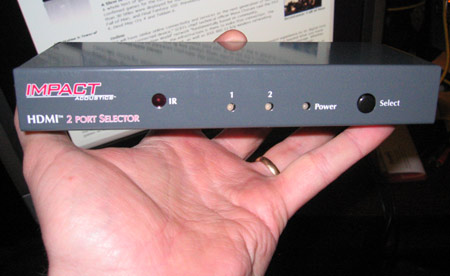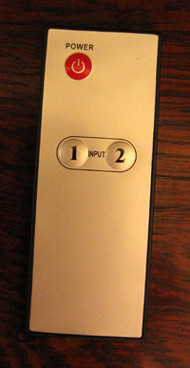Impact Acoustics Two-Port HDMI Selector Switch Review
By Chris Boylan
Two Ports Are Better Than One
The home theater electronics market is currently in a state of transition. In fact, it usually is, but at the moment there is a whole lot of transitioning going on. We are transitioning from analog NTSC TV to digital ATSC and QAM HDTV, from DVD to Blu-ray Disc and/or HD-DVD (depending on who you ask), from VCRs to DVD recorders and Hard Drive Based DVRs (Digital Video Recorders), and from analog video to digital video connections.
This complicated mess can leave us movie and music-loving audio/videophiles with more devices than we have inputs. And this is where
Impact Acoustics' Two-Port HDMI Selector Switch comes in. It accepts two HDMI inputs, and sends one HDMI output to your display or home theater receiver, allowing you to add an extra HDMI-capable device to your system without upgrading your display or home theater receiver.
HDMI: HD? Oh My!
Although analog component video connections
can carry high definition video signals all the way up to 1080p resolution (1920x1080 pixels progressive), most electronics manufacturers limit their component video outputs to 1080i (1920x1080 pixels interlaced), or even less in the case of upconverting DVD players. Even so, if you're connecting a standard definition video game system or standard DVD player, or a high definition set top box or cable box to an HDTV, component video is more than up to the task. But if you want to pass a "Full HD" 1080p signal from source device to display, or if you want to take advantage of next generation lossless audio codecs from Dolby and DTS, then you're going to need to go digital and that means HDMI.

Impact Acoustics Two-Port HDMI Selector Switch
HDMI (High Definition Multimedia Interface) is an all-digital connection format that sends both the video and audio signals over a single thin cable. The main advantages of HDMI over other video connections are its high bandwidth, the ability to preserve the entire signal in the digital domain as long as possible and the simplicity of being able to connect both the audio and video signals over a single wire.
A video-only digital connection called "DVI" (Digital Visual Interface) also exists on some consumer display devices - it's basically just the video portion of the HDMI signal. HDMI can be converted to DVI easily with a DVI to HDMI cable or adapter, but DVI-only displays can be a little trickier to use with some HDMI sources due to idiosyncrasies in the sources themselves. These issues are not really related to the switch under consideration here, as it passes the HDMI signal through from source to display without adding or subtracting anything from the signal.
HDMI also supports the "HDCP" (High-Bandwidth Digital Content Protection) protocol - a copy-protection scheme agreed upon by the CE industry and content owners (such as movie studios). This support should ensure HDMI's longevity and gradual adoption as the connection of choice in the digital age. The bottom line is HDMI is where it's at. And the more HDMI inputs you have the better.
The Impact Acoustics HDMI Selector Switch has two HDMI inputs and one output. So this means you can effectively add one additional HDMI input to your system. Of course, it can't give you HDMI where you have none - at least one HDMI (or DVI) digital input on your display or receiver is required in order to use this product.

The switcher features two HDMI inputs and one output.
In my case, I was using an Onkyo HDMI-switching receiver to switch all audio and video signals before sending the HDMI video output to a Panasonic plasma television. Adding a
Sony PS3 (PlayStation 3) Blu-ray Disc player to a system that already included a Sony HD PVR and a
Toshiba HD-DVD player would have been difficult, and would not have allowed me to take full advantage of the performance of the PS3.
But by adding the HDMI switcher to the mix, I was able to unplug the HD-DVD player from the receiver, plug that device and the PS3 into the switcher, then plug the switcher's output into the receiver's input and voila! up and running. There is a slight delay (a few seconds) when switching sources on the selector, but this appears to be more due to the HDMI "handshake" that occurs between source and display and does not seem to be exacerbated by having the switcher in the mix.
To further simplify things, I spent a few minutes at the computer adding the Impact Acoustics switcher's remote codes to a
Harmony 1000 remote we have in for review, as well as updating the associated activities. This way the Harmony remote automatically powers up and switches the switcher to the appropriate input for each activity.
By the way, quick aside, if you also own a Logitech Harmony remote, and you purchase the Two-Port switch, you might have trouble finding the right codes. Try using the numeric model number (40364) as the device's model number in the Harmony set-up software. The Harmony database could not find a match for a "2-Port HDMI" but it did find a match for the model number. I assume "Two-Port HDMI Selector Switch" would also work (spell out the word "Two").

Hard to believe you can fit 1920x1080 pixels of resolution inside this tiny little box.
In day to day use, the HDMI Switch did exactly what it was supposed to do: switch. It switched from the Blu-ray Disc player to the HD-DVD player, and from the HD-DVD player back to the Blu-ray player. It did not play favorites in this format war. It was like Switzerland, completely neutral, letting the next generation disc players take their turns doing their respective things.

The selector's slim remote includes direct input access which makes programming a universal remote that much simpler.
Because the switch is simply a signal selector and repeater (adding no processing to the mix), it had no trouble switching between HDMI 1.3 format 1080p signals and HDMI 1.1 1080i signals from an earlier HD-DVD player we had in the system for a while. It simply passed along the signal, be it 480i, 480p, 720p, 1080i or 1080p directly from the source to the receiver (and then on to the display).
I noticed no degradation of performance, no synchronization issues between audio and video, no hiccups in the HDMI "handshake" between source and display. Occasionally the Harmony remote did not properly switch the input but this was probably caused by not pointing the IR remote in the right direction during the turn-on/input selection stage of activity start-up. A quick visit to the Harmony's "help" screen straightened that out in a jiffy.
The Infrared remote sensitivity probably could be a little better. From 8 feet away, the remote generally had to be within about a 60 degree to 80 degree field in order to operate consistently. Also, the power indicator light is a little odd. When the unit is off, the green light on the front is lit, and when power is on, the light stays lit, but the input indicator LED (1 or 2) is also lit. I would expect powering the unit off to actually turn off the Power light. But these are minor gripes, and easy to get used to.
My only other complaint is that two HDMI inputs may not be enough for some people. It is important to note that this selector switch can supplement an existing HDMI-switching receiver or display, effectively turning a 3-HDMI input system into a 4-HDMI input system and this one extra input may be good enough to tide you over. Although the list price ($84.99) may seem a tad steep, you can get it for less online via
Amazon.com marketplace sellers as well as on
Impact Acoustics' own web site (see 20% off coupon code below). It's certainly a better/cheaper option than having to upgrade an otherwise perfectly adequate display or receiver. And for those who need more, Impact Acoustics has just introduced a
5-port version which allows you to switch between a whopping five different HDMI devices for only about $45 more.
Final Thoughts
If you're looking for a quick fix to add an extra HDMI input to your HDTV or home theater receiver, then the Impact Acoustics Two-Port HDMI Selector Switch may be just what you're looking for. It operates cleanly and transparently, passing along whatever signal you give it without editorialization and without any glitches. And in this sometimes complicated digital world, that's no mean feat.
Where to Buy:Specifications from the Manufacturer:- MSRP: $84.99
- Color: Grey
- 2 HDMI Inputs, 1 HDMI Output
- Fully HDCP compliant for use with High Definition Movies and Broadcasts
- Supports DDWG standard for HDMI compatible monitors
- Direct input selection via IR Remote or front panel
- Input Resolutions Supported: 480i, 480p, 720p, 1080i, 1080p
- Weight: 3.5 pounds
- Warranty: 1 Year
- Package Contents:
- HDMI Selector Switch
- Remote Control (battery included)
- Power Adapter
- User Manual
Manufacturer's Contact Details:
Impact Acoustics
1501 Webster St.
Dayton, OH 45404
Phone: 877-AV-EXPERT (877-283-9737)
Fax: 800-331-2841
Web Site:
www.impactacoustics.com



